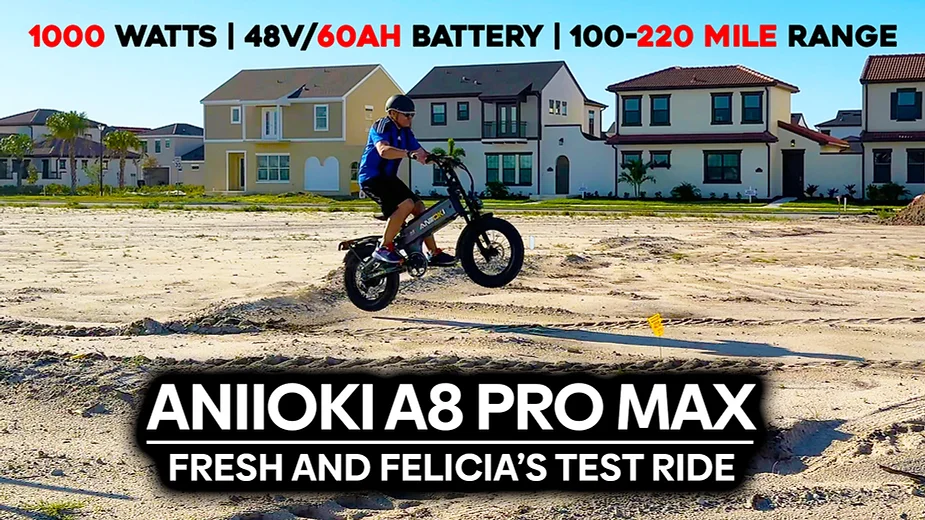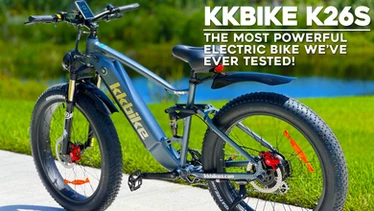There’s a new all-star in the crafting space – laser engraver and cutting machines. Forged by the success of Glowforge in 2018, crafters worldwide are migrating to this more interesting and dimensional platform. You could spend upwards of $20,000 on one of Epilog’s fancy CO2 (carbon dioxide) lasers, but this is out of most hobbyist budgets. Diode (LED) lasers are more affordable and can do 90% of what most people want to do with a laser engraver. The big question is, when comparing the xTool M1 versus WeCreat Vision entry level models, which is the better laser engraver? The Family Unit’s Fresh and Felicia put both of these machines to the test.
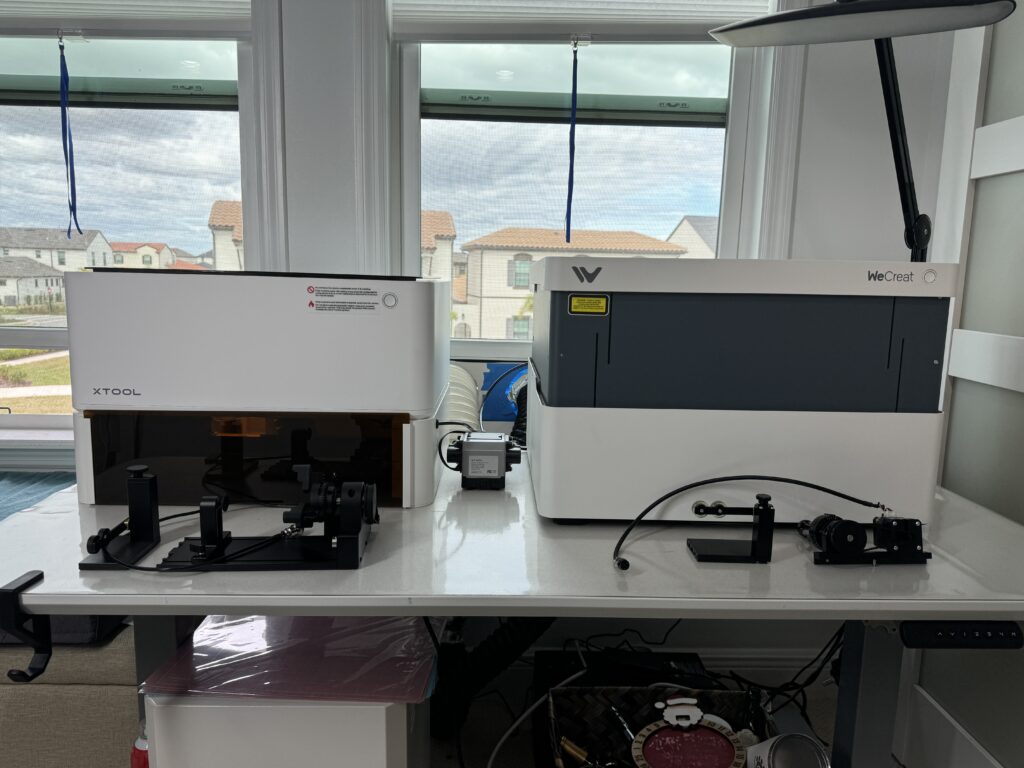
The Growth of Affordable Laser Engraving
Crafters around the world began buying paper and vinyl cutting machines by the likes of Cricut, Silhouette, and Sizer during the pandemic. Business was booming for those companies, and with good reason. While many stores were closed and people were locked down, folks could create their own personalized greeting cards, t-shirts, tumblers, and a variety of cool knick knacks to give as gifts or sell on Etsy. It was a perfect storm for these craft machine manufacturers.
Fast forward to 2024, and Facebook Marketplace is now littered with vinyl cutting machines for sale (including ours). It’s really no surprise when you think about it. Vinyl is easy and cheap, but eventually peels away or cracks on decor, drinkware, and on garments. Most personalized commercial products are embroidered, screen or laser transfer printed, or engraved. This results in a classier, more professional look that is more permanent. Vinyl is great for accenting some crafts with vivid colors, but it was never really intended to be a primary material.
We began our laser engraving journey about three years ago when Latitool sent us their F50 open-face laser engraving machine, similar to xTool’s M1 model. After managing to decipher the assembly manual and install the clunky third-party software, we were impressed with the potential in this creative space. We had to use it outdoors, having no way to ventilate the potentially toxic smoke that occurs when burning wood and other materials.
Laser engravers have evolved. There are now fully enclosed laser cutters that are much easier to use and suitable for in-home use with proper filtration. We received both the xTool M1 and WeCreat Vision to review. While they are both affordable, easy to use, and powerful full enclosure diode laser engravers, one is our runaway favorite. We’ll explain which is our favorite and why later in this article.
Before we begin, let’s look at a summary of the key features of the xTool M1 and WeCreat Vision laser engraving machines.
xTool M1 Laser Engraver and Vinyl Cutter
Introduced back in 2022, the xTool M1 is machine that allows engraving of wood, some acrylics, and even some metals. The groundbreaking development made by xTool is the inclusion of a rotary blade, similar to the one found in high-end vinyl cutting machines. Add fabric, leather, paper, cardstock, and vinyl to xTool M1’s capabilities. Yes, there is print and cut functionality that enables you to make stickers. This allows you to save money and space by having both devices occupy a much smaller space in most craft rooms. It’s a very capable machine that’s perfect for users breaking into and experimenting with cutting and engraving different materials in the comfort of your own home or office.
- Type: Hybrid laser engraver, cutter, and vinyl/fabric/cardstock cutter
- Laser Power: Class 1 diode laser, Available in 5 Watt and 10 Watt models
- Internal Camera: 12 MP
- Engraving Speed: up to 250mm/s (bitmap processing); 160mm/s (vector processing)
- Accuracy: 0.01mm
- Software: xTool Creative Space software includes 500+ elements, 30+ fonts, various editing functions, and step-by-step project files. Works with SVG, DXF, JPG, PNG, BMP, TIF, CR2.
- Material Capability: Capable of cutting and engraving a variety of materials including wood, leather, fabric, paper, and some non-clear plastics. The 10W option supposedly cuts up to 8mm basswood. The separate (included) rotary blade allows it to cut materials like vinyl and fabric.
- Working Area: 11.811″ x 15.15″ (laser); 11.811″ x 14.37″ (cutting blade)
- Special Features: The world’s first 2-in-1 laser engraver and vinyl cutting machine, providing additional material versatility.
- Price Range: $999 and up depending on features and accessories.
WeCreat Vision Laser Engraver
The WeCreat Vision is a relative newcomer to the laser engraving space. Apparently they saw shortcomings in competing laser engraver products, and offered effective solutions in their base product that can save users considerable money and time. There’s no cutting blade in the Vision, so the materials it can work with are more limited.
- Type: Laser engraver and cutter
- Laser Power: Class 1 diode laser, 20 Watts
- Internal Camera: 12 MP
- Engraving Speed: up to 600mm/s maximum engraving speed, claiming to be up to 375% faster than other full-enclosure diode laser machines
- Accuracy: 0.01mm
- Software: WeCreat MakeIt! software supports Windows / macOS / iPadOS/Android/iOS and offers thousands of free ready-to-make, editable projects. Or, import or create a new design from within the app that works with JPG, GIF, PNG, BMP, SVG, DXF, and WEBP files.
- Material Capability: Works with a variety of materials such as wood, stainless steel, non-clear acrylic, leather, and more. Cuts up to 10mm balsa wood.
- Working Area: 11.7″ x 16.5″ x 5.51″
- Special Features: The world’s first automatically rising platform eliminates the need to purchase expensive accessories for taller projects. Air-assist is also included and pre-installed.
- Price Range: $1199 and up depending on features and accessories.
WeCreat Vision versus xTool M1 Laser Engraving Test Comparison
We tested the WeCreat Vision and xTool M1 with the same exact file using the recommended cutting, scoring, and engraving power and speed recommended within each machine’s software for 3MM basswood. We used generic 3mm basswood we bought on Amazon for both machines, mainly because it’s cheap, it’s easily available, and it’s what we had on the shelf that day. All laser engraver machines should be able to use any brand wood. WeCreat sells colored and patterned MDF wood on their website. It’s a little pricey, but we can honestly vouch from the samples we received that the quality is top notch.
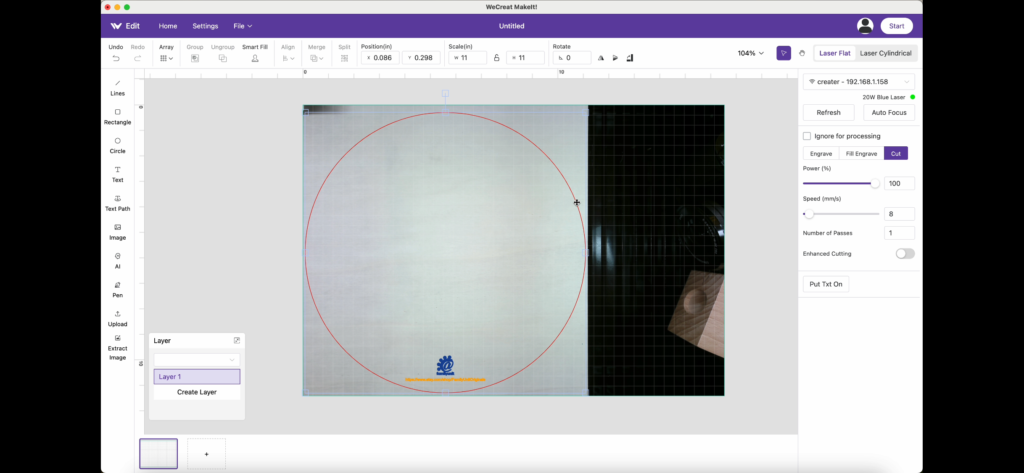
xTool’s Creative Space and WeCreat’s MakeIt! are both free and powerful apps that enable crafters to create and modify simple to complex designs. They are fairly easy to use with a slight learning curve, and they are updated with new features frequently. If you’re coming from vinyl cutting software like Cricut or Silhouette, you’ll be immediately familiar with most of the functionality. For our speed test, we cut a simple circle of just under 12″, engraved our YouTube logo, and attempted to score (engrave the outline) of small text showing our website. We thought this would be a good test of incorporating the three basic functions any average user might try soon after taking their laser engraver out of the box.
For more intricate custom laser cut and engraving features and designs, you may need to move to Adobe Illustrator or Lightburn software. You will need to export your project as an SVG into either of the two laser engraver software programs.
We found that the WeCreat Vision completed our simple test project in 247 seconds, one minute and 5 seconds faster than 312 seconds it took the 10W xTool M1. The 21-ish percent time savings may not seem like a big difference for the home hobbyist until your side gig succeeds. When you get to the point you need to cut and engrave multiple objects, this can result in significant time saved. The cut was perfect and clean on both machines using the default settings. Both machines have air assist installed so there was very little residue around the cut edges.
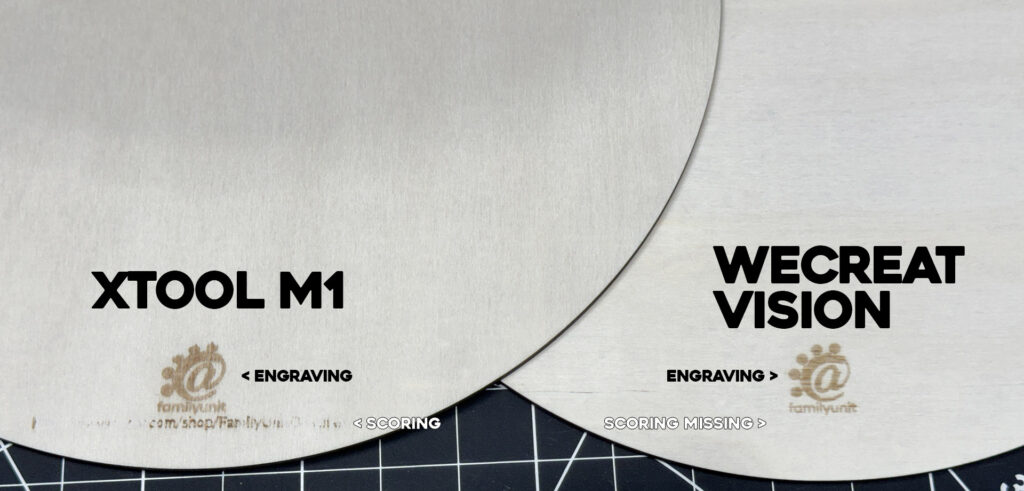
The engraving was light yet clean and accurate on both machines. We would have preferred it a little darker on both test circles. Personally, we never use the default or recommended power and speed settings when engraving on anything. We always engrave a sample matrix or array in each material to determine the power and speed settings for our desired result. We would have preferred a much darker engraving if I were producing these for sale.
The WeCreat Vision failed completely on the scoring test using the recommended power and speed for 3mm basswood. xTool M1 failed as well, as it did not achieve a full score either with parts of the scored words completely absent. On laser engravers, “scoring” is basically a very thin engraving of the outline of letters or a shape. Our problem can be easily resolved by increasing the power or passes, or decreasing the time so the laser spends more time on the area we want to score. We rarely use the scoring function, so we weren’t overly concerned with this result on either machine.
Which is the better laser engraver?
Price and feature-wise, these two machines finally bring enclosed laser engravers to a price point that’s manageable to many home crafters. And that’s a great thing! But we are savvy shoppers, and we abhor when companies “nickel and dime” for accessories you could live without, but are really essential when you get into this space. Think air assist, which blows air near the laser head for cleaner cuts and helps to keep the laser lens clean. And a riser assembly that allows you to engrave taller materials like tumblers. The xTool honeycomb riser assembly is sold separately, and is clunky and difficult to work with. If you attempt to move the M1 machine with the riser attached, the base will fall apart since relies on loosely attached panels and gravity to keep it assembled. And xTool’s Air Assist is also sold separately, and can be cumbersome to install with poor instructions. It took us an hour to figure out how to feed the air hose in a manner that worked. The WeCreat Vision scores a 10/10 for including and pre-installing both of these features in their base package.
The ability to cut vinyl, fabric, leather and cardstock is an incredible innovation on the part of xTool in their M1 machine. And with the booming trend of stickers sweeping the planet, xTool offers print and cut functionality for perfect kiss cut or die cut stickers. For those who are interested in doing both laser cutting and engraving, plus keeping the ability to work with vinyl, cardstock, or stickers, the utility of the xTool M1 scores big. I can imagine many people with smaller workspaces might consider selling their Cricut cutting machines and replacing them with the much more versatile xTool M1.
WeCreat limits functionality to cutting, engraving, and scoring wood, cardstock, some metals, and some acrylics. However, this is exactly what people expect any laser cutting and engraving machine to do. Anything beyond that is simply a bonus.
With 20 Watts of diode laser power, WeCreat Vision offers faster engraving and cutting speeds. As you ramp up your production, most users find the added speed helpful to increase efficiency. xTool M1 is only available in 5 and 10 Watt variants. WeCreat wins hands-down 10/10 in the efficiency department.
In terms of accuracy, when we engraved steel tumblers using the WeCreat Vision, we saw an incredible amount of detail that’s typically not visible when engraving wood. With one of our designs, we even saw shades of gradient in the metal, which was very surprising. Our social media icons were quite detailed considering they were only 5 mm square. Score 10/10 for WeCreat in the accuracy department. xTool’s M1 tumbler engraving resulted in some jagged edges using a similar design with similar settings. Further testing is required to determine xTool’s true accuracy in tumbler and metal engraving.
We attempted to engrave stainless steel rings using the WeCreat Vision rotary assembly, but could not get the correct alignment without an inconvenient workaround. We are working on a solution for this with WeCreat. We have not attempted this with our xTool M1 as of this writing but will report back when completed.
When shopping for a laser engraving machine, it’s best to look at the specific features including laser power, working area, material compatibility, and any additional features like software compatibility or safety features. Additionally, considering community feedback can provide insights into the reliability and performance of each machine in real-world applications.
If you decide to purchase either of these laser engraver machines, please support our blog and YouTube channel and use our affiliate links. The prices are exactly the same using our links, and they forward directly to the vendor’s websites. Thank you.
- xTool official website: https://www.xtool.com/?ref=UGCz6D7smUafd7&utm_medium=5306&utm_source=influencer
- WeCreat Vision official website: https://shrsl.com/4e0gb
We will continue to update this post as we evaluate further head-to-head results. Can you diode-laser engrave a 2.5″ Aztec calendar at 300 DPI with the precision of a CO2 laser? Let’s just say it’s not looking great. Would you do this in the real world? Probably not, but it’s good to know the capabilities of your machine. In the meantime, have a look at some of the projects we’ve created with both of these amazing laser engraving machines.

